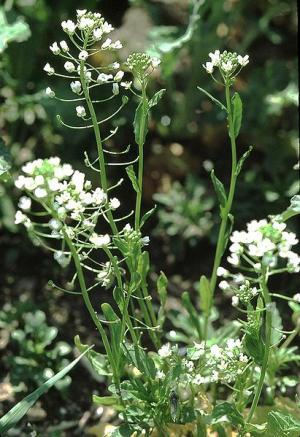Field Pennycress

Thlaspi arvense (common name Field Penny-cress or Stinkweed) is a naturalized herb found throughout North America. It is also related to the Lepidium species in the cabbage family. Native to Asia (or, according to some authorities, the Mediterranean), it has been introduced into most parts of the world, and is now regarded as a damagingly invasive species by most authorities. The plant is a winter or summer annual that grows 1–2½' tall, branching occasionally. These leaves are oblanceolate or obovate and have long petioles. The flowers are attractive, about 1/8" across when fully open and have 4 white petals and 4 green sepals. The (fruit) seedpods have 2 cells, each containing several seeds, which are surrounded by a wide membranous wing. There is a small notch at the top of each one.
The plant contains contains large quantities of glucosinolates, which release ally lisothiocyanate upon hydrolysis. Ally isothiocyanate, is a potent irritant that has also shown fetotoxic and carcinogenic effects in laboratory rats. Most sources list the seeds as being the most toxic portion of the plant, but the leaves are toxic as well. The Canadian Biodiversity Information Facility, which contains a large database of information on poisonous plants and past poisoning cases states that “tests of stinkweed showed that the allylthiocyanate (a glucosinolate) content is sufficient to cause sickness and death in cattle; fatalities occurred at about 65 mg/kg of body weight. The amount of this chemical varies with the stage of maturity of the plant; the highest amount is in the seeds (Smith and Crowe 1987, Majak et al. 1991).” Another potential danger posed by this plant in addition to the actual chemicals the plant produces is the fact that these plants readily absorb, accumulate, and store environmental toxins, such as pesticides and nitrates. Toxins which are then passed onto the animal that chooses to ingest the plant.
The overall threat to livestock posed by these plants is low, as most animals find them to be relatively unpalatable. As a result they will typically ignore them unless other food sources are limited. Due to the weedy nature many plants of this genus possess they can, however, infest pastures, choking out other non toxic plants; essentially forcing themselves on grazing animals and thus becoming the bulk of their diet. Poisonings occur most commonly as the result of contaminated hay.
Avoid further ingestion of the plant and consult a veterinarian. Life threatening intoxication is rare, fatalities, while possible are rarer yet. Due to the limited amount that animals are likely to consume, serious intoxication is rare and in most cases ingestion will only result in moderate to severe gastrointestinal disturbance. In regards to a specific treatment regimen, in most cases involving a limited ingestion common sense symptomatic care will probably be all that is required. If the ingestion was recent (dogs and cats) remove any existing plant matter from the mouth and flush thoroughly with water. If vomiting does not occur it may be induced by giving and emetic such as 3% hydrogen peroxide orally at a dose rate of 1 teaspoon per 10 lbs of body weight. The pet (dogs and cats) will more than likely start vomiting spontaneously without the help of an emetic, as their body tries to expel this non digestible material. The universal antidote, activated medical charcoal may also prove to be of some use in absorbing the toxins.
Ensure the pet gets plenty of fluids to avoid possible dehydration caused by diarrhea. To alleviate the gastrointestinal upset and diarrhea; Kapectolin may be given at a dose rate of 1 to 2 ml/kg four times a day. Kapectolin provides a coating action that protects the stomach lining. Sucralfate may also be used as for gastrointestinal irritation as it reacts with the acids in the stomach to form a paste-like material capable of acting as a barrier between the stomach and its contents. Sucralfate is typically given to dogs weighing more the 60lbs: 1g every 6 to 8 hours; for dogs under 60 lbs: 0.5g every 6 to 8 hours; Cats: 0.25g every 8 to 12 hours to reduce irritation of the stomach and intestines. The prognosis is generally excellent, provided the animal is not suffering the ill effects of environmental toxins that were stored in the plant. With symptomatic care most animals will make a full recovery in a few hours to a few days.
In grazing animals that may choose to ingest a considerably larger amount of the plant the prognosis can vary from good to grave depending upon how much was ingested and over what period of time. The Canadian Biodiversity Information Facility, which contains a large database of information on poisonous plants and past poisoning cases states that: “cattle that ingested hay containing between 25-100% stinkweed were colicky and some abortions occurred. Necropsy of cows revealed massive submucosal edema of the wall of forestomachs, particularly in the rumen. Lowering the rumen pH to 5 reportedly stops the allylthiocyanate from forming. However, more recent work found that lower pH did not significantly affect the liberation of allylthiocyanate. Administering large doses of piperazine (110 mg/kg) to rapidly reduce the concentration of toxin has been suggested. Ensiling hay containing stinkweed apparently prevented liberation of allylthiocyanate (Smith and Crowe 1987). Yield of the chemical is a function of the diet, with alfalfa herbage allowing the lowest release quantity (30%) and alfalfa hay the highest yield (72%) (Majak et al. 1991).”




